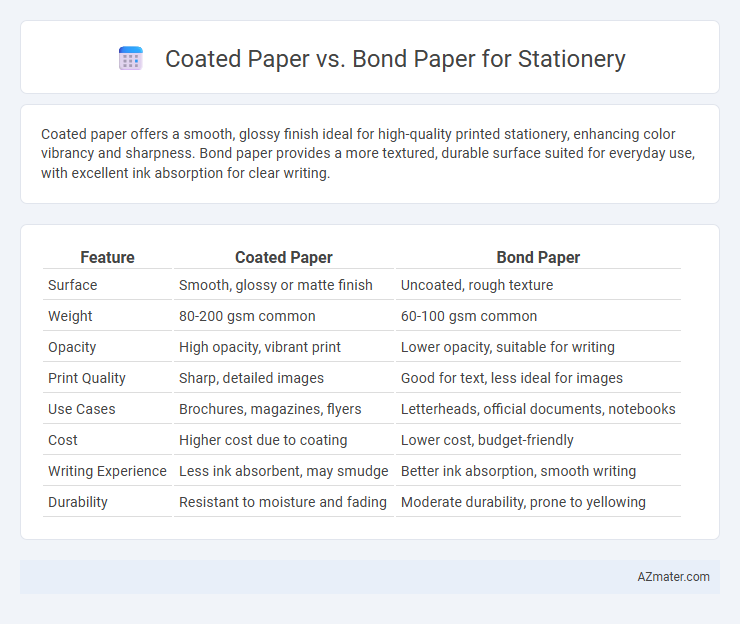Coated paper offers a smooth, glossy finish ideal for high-quality printed stationery, enhancing color vibrancy and sharpness. Bond paper provides a more textured, durable surface suited for everyday use, with excellent ink absorption for clear writing.
Table of Comparison
| Feature | Coated Paper | Bond Paper |
|---|---|---|
| Surface | Smooth, glossy or matte finish | Uncoated, rough texture |
| Weight | 80-200 gsm common | 60-100 gsm common |
| Opacity | High opacity, vibrant print | Lower opacity, suitable for writing |
| Print Quality | Sharp, detailed images | Good for text, less ideal for images |
| Use Cases | Brochures, magazines, flyers | Letterheads, official documents, notebooks |
| Cost | Higher cost due to coating | Lower cost, budget-friendly |
| Writing Experience | Less ink absorbent, may smudge | Better ink absorption, smooth writing |
| Durability | Resistant to moisture and fading | Moderate durability, prone to yellowing |
Introduction to Coated Paper and Bond Paper
Coated paper features a smooth surface with a layer of compounds like clay, offering enhanced brightness and print sharpness ideal for vibrant stationery designs. Bond paper, characterized by its uncoated, sturdy texture, is favored for everyday office use due to its durability and ink absorption. Both paper types differ significantly in finish and usability, influencing stationery quality and application.
Defining Coated Paper: Features and Uses
Coated paper features a smooth, glossy, or matte finish achieved by applying a layer of coating materials such as clay or polymers, enhancing ink absorption and image sharpness, making it ideal for high-quality printing tasks like brochures, flyers, and magazines. Its surface prevents ink from bleeding, ensuring vibrant colors and crisp detail, which is essential for visual-centric stationery. Coated paper suits applications requiring a professional, polished look but offers less flexibility and writeability compared to bond paper, often used for official correspondence and everyday printing needs.
Understanding Bond Paper: Characteristics and Applications
Bond paper, known for its durability and smooth texture, is a preferred choice for everyday stationery such as letterheads, forms, and official documents. It features a slightly rough surface compared to coated paper, which enhances ink absorption and prevents smudging, making it ideal for writing and printing. Commonly made from high-quality cotton or wood pulp, bond paper combines strength with affordability, ensuring longevity and professional appearance in business communications.
Visual Appeal: Print Quality on Coated vs Bond Paper
Coated paper offers a smooth, glossy finish that enhances print quality by producing sharp, vibrant images and rich colors, ideal for high-detail stationery designs. Bond paper features a more porous, uncoated surface, resulting in softer prints with less color saturation, making it suitable for standard office correspondence. The choice between coated and bond paper directly impacts the visual appeal of stationery, as coated paper highlights intricate graphics while bond paper emphasizes a classic, professional look.
Durability and Strength for Stationery Purposes
Coated paper offers a smooth surface with a protective layer that enhances print quality but tends to be less durable and prone to cracking when folded, making it less ideal for heavy-duty stationery. Bond paper, known for its high durability and strength, withstands frequent handling and writing without tearing or smudging, making it the preferred choice for everyday stationery like letterheads and envelopes. For stationery requiring longevity and robustness, bond paper provides superior performance in terms of durability and strength compared to coated paper.
Writing Experience: Pen Ink on Coated and Bond Papers
Coated paper features a smooth, sealed surface that causes pen ink to sit on top, often resulting in slower drying times and potential smudging, making it ideal for printing but less optimal for frequent handwriting. Bond paper has a more porous texture that absorbs ink quickly, providing crisp lines and reduced smearing, enhancing the writing experience for pens, especially fountain and gel types. Choosing between coated and bond paper depends on whether the priority is glossy print quality or ink absorption for legible, clean handwriting.
Cost Comparison: Coated Paper vs Bond Paper
Coated paper is generally more expensive than bond paper due to its additional processing and finish that enhance smoothness and brightness. Bond paper remains cost-effective, making it a preferred choice for everyday stationery and mass printing tasks. The price difference is influenced by coating materials and manufacturing complexities, which significantly impact production costs.
Environmental Impact: Sustainability Considerations
Coated paper typically involves more chemical treatments and bleaching processes, which can increase its environmental footprint and reduce biodegradability compared to bond paper. Bond paper, often made with fewer chemical additives and sometimes incorporating recycled fibers, tends to offer better sustainability credentials and easier recyclability. Choosing bond paper for stationery helps minimize ecological impact through reduced chemical use and improved composting potential.
Best Uses for Coated Paper in Stationery
Coated paper is ideal for stationery that demands vibrant, high-resolution printing such as brochures, invitations, and business cards due to its smooth, glossy surface which enhances color sharpness and image detail. Its moisture-resistant coating also makes it suitable for materials requiring durability and a professional finish, like presentation folders and premium envelopes. This type of paper ensures crisp text and graphics, elevating the overall aesthetic and tactile experience of stationery products.
Choosing the Right Paper: Coated or Bond for Your Needs
Coated paper offers a smooth, glossy finish ideal for vibrant prints and professional stationery that demands sharp imagery, while bond paper provides a matte, uncoated surface suited for everyday writing and printing tasks due to its durability and ink absorption. Selecting between coated and bond paper depends on the intended use--choose coated paper for high-quality presentations, brochures, or marketing materials, and bond paper for letterheads, memos, or business forms requiring crisp, legible text. Understanding the paper's weight, brightness, and finish helps optimize stationery performance for specific printing technologies and usage scenarios.

Infographic: Coated paper vs Bond paper for Stationery
 azmater.com
azmater.com